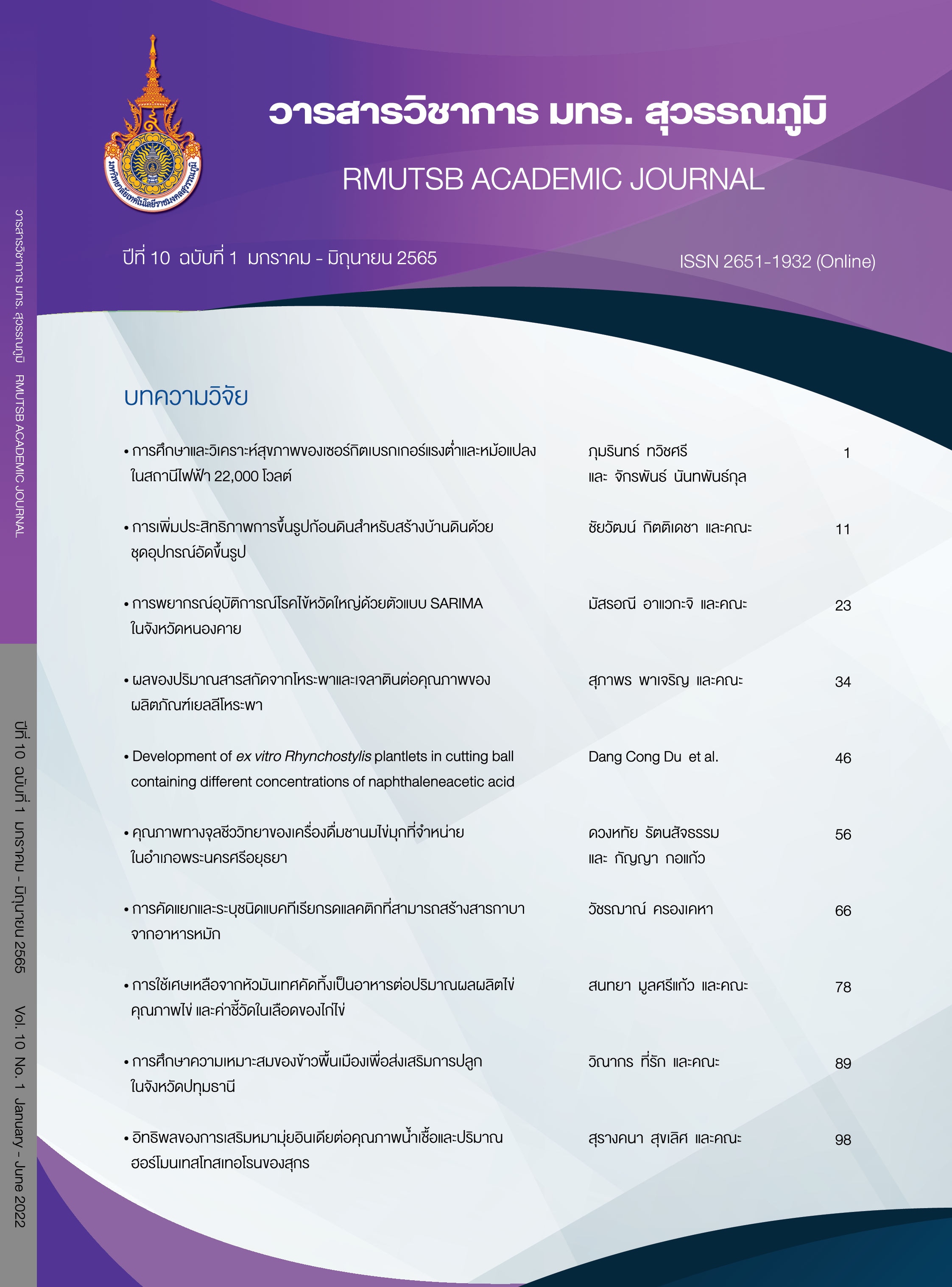The use of discarded sweet potato tuber as feed on egg production, egg quality and blood parameter of laying hen
Main Article Content
Abstract
Discarded sweet potato tubers (SPT) were abundant and cheap. This research aimed to study effects of the use of SPT as feed for feeding laying hen on egg production, egg quality and blood parameters. The research was conducted by a completely randomized design (CRD) using 41-week-old of Lohmann brown laying hens of 150 in total. The experiment was divided into 5 treatments, the pigment negative control feed formulated based on cassava chip meal (CM), positive control feed formulated based on ground corn (C), and the corn replace with SPT at 50, 75 and 100 percentage (SPT50, SPT75 and SPT100, respectively). It was found that the hen-day-egg production and egg mass of SPT50 and SPT75 had significantly higher than SPT100, while feed conversion ratio was signiticantly lower than C (P<0.05). The albumin height, Haught unit, yolk index and shell thickness of all treatments were not significantly different (P>0.05), but the CM gave the lowest egg production, egg mass and yolk color (P<0.05), but the blood parameters of all treatments were not significantly different. Therefore, the SPT could totally replace cassava meal or replace 50 and 75 percentage of ground corn without having any negative effects on egg production, egg quality and hen blood parameters. Besides, the SPT had potential source of color in the yolk similar as corn, and reduced the feed cost by 4.71 baht per kilogram of egg.
Article Details

This work is licensed under a Creative Commons Attribution-NonCommercial-NoDerivatives 4.0 International License.
Published manuscript are the rights of their original owners and RMUTSB Academic Journal. The manuscript content belongs to the authors' idea, it is not the opinion of the journal's committee and not the responsibility of Rajamangala University of Technology Suvarnabhumi
References
Afolayan, S. B., Dafwang, I. I., Sekoni, A., & Jegede, J. O. (2013). Effect of dietary maize substitution with sweet potato meal on performance of grower (10-22 weeks) and subsequent egg production (23-35 weeks). Asian Journal of Poultry Science, 7(2), 55-64.
Ahn, Y. O., Kim, S., Kim, C., Lee, J., Sang-Soo, K., & Haeng-Soon, L. (2010). Exogeneous sucrose utilization and starch biosynthesis among sweet potato cultivars. Carbohydrate Research, 345, 55-60.
AOAC. (2000). Association official method of analysis. Maryland: AOAC International.
Ayuk, E. A. (2004). Effect of sweet potato meal on the growth rate of broilers. Livestock Research for Rural Development, 16(2004), Retrieved 20 March, 2020, from http://www.lrrd.org/lrrd16/9/ayuk16073.html
Beckford, R. C., & Bartlett, J. R. (2015). Inclusion levels of sweet potato root meal in the diet of broilers I. Effect on performance, organ weights, and carcass quality. Poultry Science, 94(6), 1316-1322.
Biswas, A. K., Sahoo, J., & Chatli, M. K. (2011). A simple UV-Vis spectrophotometric method for determination of Beta-carotene content in raw carrot, sweet potato and supplemented chicken meat nuggets. Food Science and Technology, 44, 1809-1813.
Byamukama, E. R., Gibson, W., Aritua, V., & Adipala, E. (2003). Within-crop spread of sweet potato virus disease and the population dynamics of its whitefly and aphid vectors. Journal of Crop Protection, 23, 109-116.
Çaliskan, M. E., Sogut, T., Boydak, E., Erturk, E., & Arioglu, H. (2007). Growth, yield and quality of sweet potato [Ipomoea batatas (L.) Lam.] cultivars in the Southeastern Anatolian and East Mediterranean regions of Turkey. Turkish Journal of Agriculture and Forestry, 31, 213-227.
Dangpium, N. (2015). Research and development project for sweet potato production (research report). Bangkok: Department of Agriculture.
Gross, W. B., & Siegel, P. B. (1986). Effect of initial and second periods of fasting on heterophil/lymphocyte ratios and BW. Avian Diseases, 30, 345-346.
Kassa, M., Negesse, T., & Nurfeta, A. (2017). Effect of replacing maize (Zea mays L.) with orange fleshed sweet potato tuber (Ipomoea batatas) on performance of Cobb500 broiler chickens. Agricultural Research & Technology: Open Access Journal, 5, 1-9.
Kaya, S., & Yildirim, H. (2011). The effect of dried sweet potato (Ipomoea batatas) vines on egg yolk color and some egg yield parameters. International Journal of Agriculture & Biology, 13(5), 766-770.
Ladokun, O. A., Aderemi, F. A., & Tewe, O. O. (2007). Sweet potato as a feed resource for layer production in Nigeria. 8th African Crop Science Society Conference (pp. 585-588). El-Minia Egypt: African Crop Science Society.
Moonsrikeaw, S. (2018). The study of nutritive values and utilization of by – product from sweet potato for feedstuff (research report). Phra Nakhon Si Ayutthaya: Rajamangala University of Technology Suvarnabhumi.
National Research Council (NRC). (1994). Nutrient requirements for poultry. Washington DC: Natl Acad.
Nuhu, B., Abba, A., & Aminu, L. (2008). Profitability of broiler chickens raised on graded levels of maize offal and wheat offal based diets. Proceedings of Annual ASAN Conference (pp. 298-299). Abu Zaria: Nigeria.
Ravindran, V. (1995). Use of cassava and sweet potatoes in animal feeding. Rome: FAO.
Reece, O. W. (2006). Functional anatomy and physiology of domestic animals. Iowa: Blackwell Publishing.
Teow, C. C., Truong, V. D., McFeeters, R. F., Thompson, R. L., Pecota, K. V., & Yencho, G. C. (2007). Antioxidant activities, phenolic and β-carotene contents of sweet potatoes genotypes with varying flesh colours. Food Chemistry, 103, 829-838.
Tonglak, P. (2016). Food product development from sweet potato in Tub-Nam, Bang Pahan, Phra Nakhon Si Ayutthaya (research report). Phra Nakhon Si Ayutthaya: Rajamangala University of Technology Suvarnabhumi.


